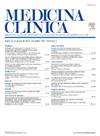减肥手术后使用GLP-1受体类似物治疗肥胖:现实生活中的证据
IF 2.1
4区 医学
Q1 MEDICINE, GENERAL & INTERNAL
引用次数: 0
摘要
大约25-30%的接受减肥手术(BS)的患者体重恢复或体重下降不理想。胰高血糖素样肽-1受体激动剂(GLP-1 RAs)已成为这些病例的治疗选择。目的评估GLP-1 RAs在控制BS后体重恢复和次优体重反应中的有效性。材料与方法回顾性研究因体重恢复或体重反应不佳而接受GLP-1 RAs治疗的BS患者。结果2015 - 2020年共953例BS患者;122人开始用GLP-1 RAs治疗。该队列由78%的女性组成,平均年龄50.4±10.6岁,基线BMI为44.7±6.3 kg/m2。治疗开始时,bs后41.9±20.5个月,平均体重减轻18.6±10%;52%的人减掉了原来体重的20%,82%的人恢复了原来体重的20%。35%的患者接受利拉鲁肽(LIRA)(1.8±0.5 mg/天)和65%的患者接受西马鲁肽(SEMA)(1.0±0.8 mg/周)治疗,平均治疗时间为19.3±17.3个月。LIRA组最大体重减轻4.7±4.8%,而SEMA组最大体重减轻8.3±5.9% (p = 0.01)。总体重减轻(BS + GLP-1 RA) LIRA组为21.6±9.2%,SEMA组为25.6±10.5%。BS +药物治疗后体重反应不佳的患者比例(20%)显著下降(从52%降至31%)。结论:sema比LIRA更能减轻体重,使其成为治疗bs后体重反弹的更有效选择。本文章由计算机程序翻译,如有差异,请以英文原文为准。
Tratamiento de la obesidad después de la cirugía bariátrica con análogos del receptor de GLP-1: evidencia en vida real
Introduction
Approximately 25–30% of patients undergoing bariatric surgery (BS) experience weight regain or suboptimal weight loss. Glucagon-like peptide-1 receptor agonists (GLP-1 RAs) have emerged as a therapeutic option in these cases.
Aim
To evaluate the effectiveness of GLP-1 RAs in managing weight regain and suboptimal weight response after BS in a real-world setting.
Materials and Methods
Retrospective study of BS patients treated with GLP-1 RAs due to weight regain or suboptimal weight response.
Results
A total of 953 patients underwent BS between 2015 and 2020; 122 initiated treatment with GLP-1 RAs. The cohort was composed 78% women, with a mean age of 50.4 ± 10.6 years and a baseline BMI of 44.7 ± 6.3 kg/m2. At the start of treatment, 41.9 ± 20.5 months post-BS, the mean weight loss was 18.6 ± 10%; 52% had lost < 20% of their initial weight and 82% had regained > 20% of the weight lost. 35% received liraglutide (LIRA) (1.8 ± 0.5 mg/day) and 65% semaglutide (SEMA) (1.0 ± 0.8 mg/week), with a mean treatment duration of 19.3 ± 17.3 months. Maximum weight loss was 4.7 ± 4.8% with LIRA vs. 8.3 ± 5.9% with SEMA (p = 0.01). Total weight loss (BS + GLP-1 RA) was 21.6 ± 9.2% with LIRA vs. 25.6 ± 10.5% with SEMA. The proportion of patients with a suboptimal weight response after BS + pharmacotherapy (< 20%) significantly decreased (from 52% to 31%).
Conclusions
SEMA led to greater weight reduction than LIRA, positioning it as a more effective option for managing post-BS weight regain.
求助全文
通过发布文献求助,成功后即可免费获取论文全文。
去求助
来源期刊

Medicina Clinica
医学-医学:内科
CiteScore
3.10
自引率
5.10%
发文量
295
审稿时长
22 days
期刊介绍:
Medicina Clínica, fundada en 1943, es una publicación quincenal dedicada a la promoción de la investigación y de la práctica clínica entre los especialistas de la medicina interna, así como otras especialidades. Son características fundamentales de esta publicación el rigor científico y metodológico de sus artículos, la actualidad de los temas y, sobre todo, su sentido práctico, buscando siempre que la información sea de la mayor utilidad en la práctica clínica.
 求助内容:
求助内容: 应助结果提醒方式:
应助结果提醒方式:


